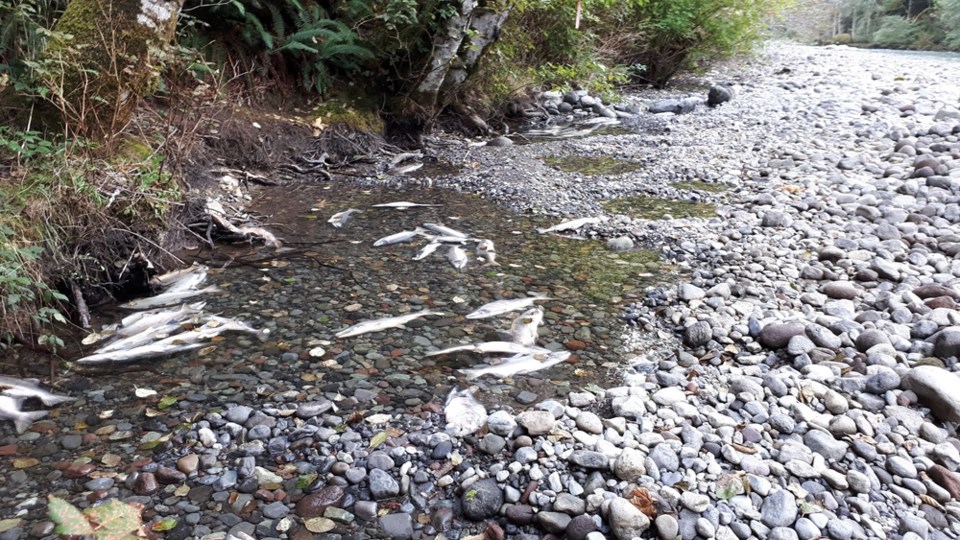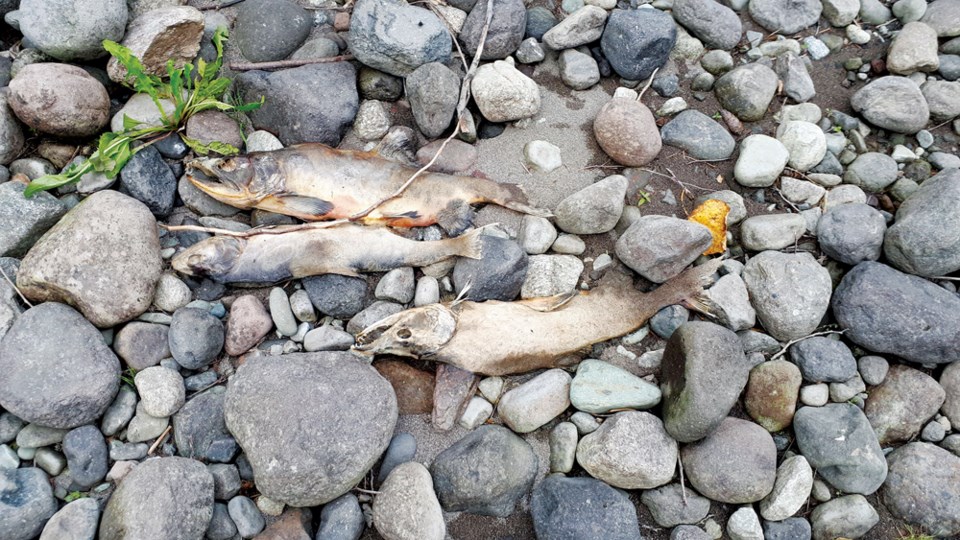It is the most dead pink salmon Squamish’s Chessy Knight has ever seen.
Knight is a biologist and president of the Squamish River Watershed Society.
“I saw at least 300 pre-spawn [dead] four days later, and some spawners still alive and in isolated pools,” she said, of spots along the Cheakamus River she visited Sept. 24.
“This is highly unusual,” she said, describing what she saw on the river at an area known as Road’s End, and a side-channel a few hundred metres downstream.
Knight says that BC Hydro seems to have cut river flows in half in less than one day while ramping on Sept. 20.
Ramping refers to increasing or decreasing water flows at a BC Hydro facility, in this case, the release from the Daisy Lake Dam on the Cheakamus River.
Though killing large numbers of juvenile fish has a negative impact, killing adult pinks about to spawn is far worse, Knight said.
The average pink adult female carries between 1,000 and 2,000 eggs, depending on her size. About three per cent of fertilized embryos return as adult spawners, she said.
So, for each female that lays say 1,500 eggs, 45 adult spawners will return.
“We need every spawner we can get,” Knight said.
Salmon redds were also destroyed by the process.
A salmon redd is a depression in the riverbed where the female salmon deposits eggs during the one or two days she is spawning.
Knight reiterated that no one expects zero impact on fish from BC Hydro projects.
She also acknowledges that there was heavy rain prior to the Sept. 20 ramp, which meant BC Hydro would have had to release some of its extra water.
They should not have ramped so fast, regardless, she maintains.
“There has to be a middle ground,” she said.
“Drop it over days. We may still have had some losses, I am not going to say we wouldn’t, but potentially not hundreds.”
Knight and other fish conservationists, have previously spoken out about the ramping rates and their impact on fish locally and at BC Hydro’s other facilities around the province, which they say have similar procedures.
BC Hydro could have and should have sought advice from the water use planning consultative committee, on which Knight sits, or from Fisheries and Oceans Canada (DFO) officials on the ground before the ramp, according to Knight.
“We didn’t really have pinks back in this watershed until 2001. In the whole water-use plan, pinks were not even included, because they weren’t in the watershed.... they have never really been contemplated in the operations of BC Hydro.”
BC Hydro says its operations on the Cheakamus River are complex with several interests to balance, including power generation, public safety, fish and wildlife, and flood control.
“We have a team made up of individuals from various parts of the organization that work together with stakeholders, First Nations and regulators to balance these needs, trial new practices, and monitor results to find solutions that work best for all,” said company spokesperson Tanya Fish.
In terms of the Sept. 20 incident specifically, she said that a late summer substantial rainfall event in the Cheakamus watershed required the company to increase flows down the river “to prevent exceeding our maximum reservoir levels and ensure public safety.”
Following the storm, the flows down the river were reduced.

The company was aware of the large number of spawning pink adults in the river as well as the presence of coho and steelhead fry, Fish said.
“The protection of these fish was a priority as we managed our flows following this rain event. Based on learnings from previous monitoring carried out under the Cheakamus Adaptive Stranding Protocol (CASP), we implemented a ramp rate of 2.5 cm per hour to mitigate fry stranding. At the same time, we were also mindful that higher water levels may encourage the pinks to spawn in the habitat that will subsequently become de-watered. As a result, within the context of the slower ramp rate overall, we moved to reduce flows to 20 cms at Brackendale as soon as possible.”
Knight, however, said that the slower ramp rate wasn’t enough to prevent the deaths, due to how much water was cut.
“I don’t know that any ramp rate can protect adult spawners from that,” she said.
“It doesn’t matter if you ramp slowly, in this particular case, when you cut the river flow by 50 per cent... you are going to affect fish.”
“If you were running at 40 cms and you are going to drop back down to 20 cms, which is where they are supposed to be under the Water Use Plan, you need to do that over days,” Knight said.
BC Hydro says that following this ramping event, crews were out on the river collecting data to assess the effectiveness of the ramp rate.
“While our preliminary data shows this rate was effective at reducing juvenile stranding, the number of adult pinks observed stranded was greater than expected and not the result we intended of a slower ramp rate. Upon observation of the stranded adults, we immediately mobilized crews to save the stranded and isolated adults,” she said.
Fish added that the goal of the Cheakamus Adaptive Stranding Protocol is to determine how to best minimize the number of fish deaths in the Cheakamus River due to BC Hydro’s operations, and then bring forward what is learned for consideration in its Water Use Planning Order Review.
“The observations of stranded adults and redds, following the latest reduction in flows, highlights the need for consideration of mitigations alternatives, in addition to reduced ramp rates, when spawning adults are in the river,” she said.
BC Hydro has been working with the DFO to address stranding mortalities as part of its Fisheries Act Authorization for this facility, Fish added.
“We have been proactive by working with regulators, First Nations and the community to develop and implement the stranding protocol.”
Where are the regulators?
Angler Dave Brown says that over concern for the stock, the Squamish-Lillooet Sportfish Advisory Committee, which he chairs, requested that DFO ban people from retaining pink salmon this season.
“Everybody is trying to do their part and here we allow Hydro to continue to kill fish... steehead, coho and now spawning pink adults,” he said.
“We have been asking DFO for answers and why they are not acting on this. They are the regulator, they can enforce this and they are not. And that is upsetting.”
Fisheries and Oceans Canada (DFO) is responsible for the regulation, conservation, and protection of fish.
“[BC Hydro] should have consulted beforehand with the regulators and with us as the stakeholders... their own consultants.”
BC Hydro has an authorization — permission — to kill fish as part of their operations, but Knight says it is a mystery how many they are allowed to kill.
“BC Hydro’s authorization for its Daisy Lake facility doesn’t have a number in it,” she said.
DFO has the power to enforce, but they aren’t, she added.
The authorization expired in 2014, which would have been an opportune time to renegotiate how many fish could be killed, but instead, the original authorization was extended to 2024, unchanged, according to Knight.
“When does it stop?” she said. “Who is next? Chum are coming in next.”
BC Hydro did not answer The Chief’s question about how many fish the company is allowed to kill under its operating authorization.
The DFO did not respond to The Chief’s repeated requests for comment by the paper’s print deadline.
Video courtesy Chessy Knight
Dead spawner or stranded?
Squamish residents will note that there are many dead salmon that died naturally after they spawned.
Knight said it is fairly easy to tell the difference between spawned-out salmon and those killed by ramping.
A spawned salmon is usually on the edge of the water and has a discoloured look.
“The skin is starting to deteriorate,” she said. “The carcass is still wet because it is still in the water.’
Stranded fish are very far from the water’s edge and they are dried out and their colours are clearer than a spawned salmon.
Knight, a biologist, said that compressing on the dead fish near their pelvic fin to see if eggs come out.
She did this to some of the fish she discovered on the Cheakamus.
“You can certainly tell the difference,” she said, adding some seemed to have died right before they spawned.
“The way that they are dispersed, completely dry, completely out of the water.... in groups.”



